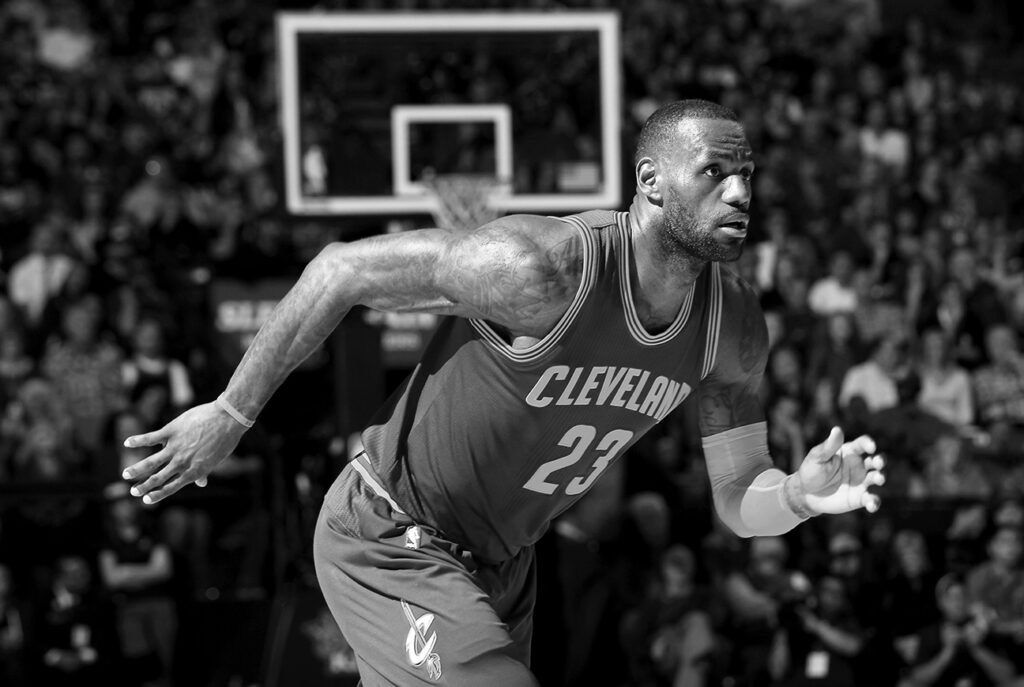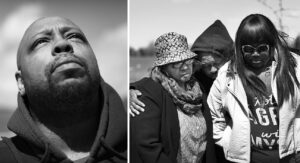LeBron James’ outraged response to the horrific shooting of an infant in Cleveland suggested the game’s biggest star might become its loudest activist. And then he went silent. Why?

Charles Wakefield buckled his 5-month-old daughter, Aavielle, into his Oldsmobile, tightened the straps on her new car seat and double-checked the infant safety locks.
His girlfriend climbed into the driver’s seat, and Charles kissed her goodbye before stepping back from the car. “Be safe,” he told her, because that was what he always said, even though his girlfriend, mother and daughter were driving just four blocks to Save-A-Lot to shop for his birthday cake. Tomorrow he would turn 38.
It was the first day of October and also nearly the beginning of the NBA season — his favorite time of the year. The Cavaliers had long been his preferred distraction from the blight of East Cleveland, and this year he coveted escape more than ever. The past month had been the city’s most violent in recent history, with 19 people shot dead, including several shootings near Charles’ house. He had grieved for three friends and two neighborhood toddlers caught in deadly crossfire, and each time he had pushed Aavielle in her stroller to their memorials.
“Mini-me,” he called her, because she had his dark eyes, his rounded cheeks and his throaty laugh, and because she went with him everywhere during the day while her mother worked. Charles had already bought her a LeBron James T-shirt to match his own.
Charles walked back toward the apartment where he lived with his girlfriend and Aavielle, but his cellphone rang before he could reach the door. It was his mother, who had promised to call from Save-A-Lot to give him a choice of frostings. “Tell me they got the buttercream,” Charles said as soon as he answered the phone, but on the other end he heard muffled screams. “What is it?” he asked, and now he thought he could make out sirens and hysterical sobs. “What? What?” he shouted.
“It’s the baby,” his mother said, finally. “She got shot.”
During a terrible year of gun violence and racial tension in Cleveland, in a historically bad month, Charles began sprinting from his apartment toward the city’s latest crime scene. There, in the fading daylight of rush hour, was his Oldsmobile, riddled with bullets because shooters had mistaken it for a different car. There, sprawled out on the hood, was Aavielle. One of the bullets had pierced the edge of her plastic car seat, hitting her in the side. Charles’ mother had lifted her onto the hood to administer CPR, and with each chest compression blood trickled out from the baby’s nose. “Oh god!” Charles screamed, and he thought he saw Aavielle lift her eyes at the familiar sound of his voice. But when he picked her up, she was limp in his arms.
He cradled her at the crime scene, at the hospital and then for a long while after doctors said there was nothing more they could do. Her skin started to gray. Blood soaked into her sweater. Charles asked doctors to bring more blankets so he could continue to hold her, and as he rocked his daughter at the hospital, the leaders of a city inured to gun violence began repeating Aavielle’s age on the nightly news and grieving not only for her but for what Cleveland had become.
“When are we going to stop counting babies being killed in our streets for nothing?” police chief Calvin Williams said that night. “This pervasive violence is crippling us at our core,” said Marcia Fudge, a U.S. congresswoman.
In those first few hours on Oct. 1, one voice in Cleveland resonated loudest of all. LeBron James was the one person in the city who remained equally popular with politicians, big corporations and residents on the Lower East Side. For more than a decade, he had moderated his political voice, usually speaking in universalities, but on this night he heard about Aavielle and reacted on social media with raw indignation.
“Like seriously man!!!!” he wrote on Twitter to his 23 million followers. “A baby shot in the chest in Cleveland. It’s been out of control but it’s really OOC. Ya’ll need to chill the F out.”
Then, three minutes later: “C’mon man. Let’s do and be better! This can’t be the only way.”

JAMES HAD BEEN watching TV on the couch in his living room when he first saw pictures of Charles’ anguished face come across the news feed on his phone. James’ own children, ages 11, 8 and 1, roamed the family’s 19-room estate on Idlebrook Drive. Their house was set on 7 acres in the hills between Akron and Cleveland, less than an hour from Charles’ apartment, protected by 24-hour security, steel gates and a series of guardhouses scattered across the property. It was the safest place in the state.
But James had grown up in subsidized housing in a part of Akron that was much like East Cleveland, hollowed out by foreclosures, disappearing jobs and rising crime. He had started a foundation aimed at providing college scholarships for more than 1,000 children in those neighborhoods, and now his own daughter, Zhuri, was just months older than Aavielle. His reaction to her death was that of a father and fellow citizen — guttural and immediate.
“I know what I see. I know how I feel,” he said the next day to the press corps that awaited him after practice, asking about his tweets. “Obviously you’re not going to be able to take every gun out, but if there’s some big-time penalties or rules or regulations, people will second-guess themselves.”
In a career mostly spent avoiding controversy, this was perhaps James’ most unfiltered comment, and his closest observers wondered whether it might be a sign of more to come. For a decade, James had been trying to find his cultural voice, torn not only by his responsibilities to corporate sponsors that paid him $44 million each year but also by a contradiction within himself. He loved and admired the apolitical business instincts of his idol, Michael Jordan, whom James once referenced when he said in 2008: “You want to keep athletics and politics separate.” But he also admired the courage and “authenticity” of his other idol, Muhammad Ali, and wanted the freedom to “speak openly on the issues I care about,” he said in 2014.
Split like this, James cushioned his social criticism in generalities and cautious gestures. He had hosted a rally for Barack Obama in 2008, but before endorsing the candidate, James had spoken about the universal importance of voter registration. He had posed in a hoodie for Trayvon Martin — but surrounded himself with his Miami Heat teammates. He had worn an “I Can’t Breathe” shirt to protest police brutality — but only after a few other NBA players had done so first. When asked about the country’s growing racial discord in 2014 and 2015, he said things like: “We have to grow together and not apart.” Or: “I’m not pointing the blame at anybody.” Or: “Society has come a long way, but it just shows how much further we still have to go.”
The difference between James and every other athlete was that because of his basketball dominance and global fame, even his careful activism had the ability to drive the news cycle — a responsibility he seemed ready to embrace when he announced he’d come back to Cleveland in 2014. “My calling here goes above basketball,” he wrote then.
And now here came one of those opportunities to lead, on gun violence in Cleveland, which had experienced an 18 percent jump in homicides and a 31 percent increase in assaults with a firearm that year. Instead of going halfway, this time James had been unequivocal: “There’s no room for guns,” he said, during that same news conference after Aavielle’s death.
Afterward, gun control groups thanked him — while gun rights groups called him a hypocrite and posted photos of him firing a machine gun at a shooting range. Activists encouraged him to push for policy reform. Four days after Aavielle’s death, the Cavs followed James’ example and invited Charles and his family to a team scrimmage. The Cavs offered Charles box seats and gave him a tour of the court and then the locker room, where he had been hoping to meet James. He stood outside and waited, but a locker room attendant came out to apologize. James had an NBA season to prepare for, a commercial to film — so many audiences to please.
“I wanted to thank him and see if we could keep pushing the issue,” Charles said, but he didn’t blame James for not meeting him or read too much into it. “People are paying attention because of LeBron,” Charles said. “He’s trying to make sure we get some justice and see this city change.”
A few weeks later, the Cavs opened their season in Chicago, and when James walked onto the court, there was Obama, seated with the Secret Service in the front row. The president had made gun control a priority in his final year in office, and he had come to think of James as not just a great basketball player but a possible ally — an athlete who was potentially willing to break the mold of “just be quiet and get your endorsements and don’t make any waves,” Obama said.
“We forget the role that Muhammad Ali, Arthur Ashe and Bill Russell played in raising consciousness,” Obama once said. And now came a season of unrest in America in which James would have the rare opportunity to add his name to that list, if only he could first resolve the conflict within himself. Jordan or Ali? Athlete or activist?
Could he not only provide Cleveland with a distraction from its problems but help solve some of them?
“Good luck,” Obama told him, as James ran onto the court.

Outdoor learning and tending to our school garden is a big part of our day.
Outdoor learning and tending to our school garden is a big part of our day.
Outdoor learning and tending to our school garden is a big part of our day.
It started out as a preschool with five students in a church located in the heart of Princeton. Growing rapidly, the school moved into a larger church building on All Saints.
It started out as a preschool with five students in a church located in the heart of Princeton. Growing rapidly, the school moved into a larger church.
It started out as a preschool with five students in a church located in the heart of Princeton. Growing rapidly, the school moved into a larger church building on All Saints.
It started out as a preschool with five students in a church located in the heart of Princeton. Growing rapidly, the school moved into a larger church.